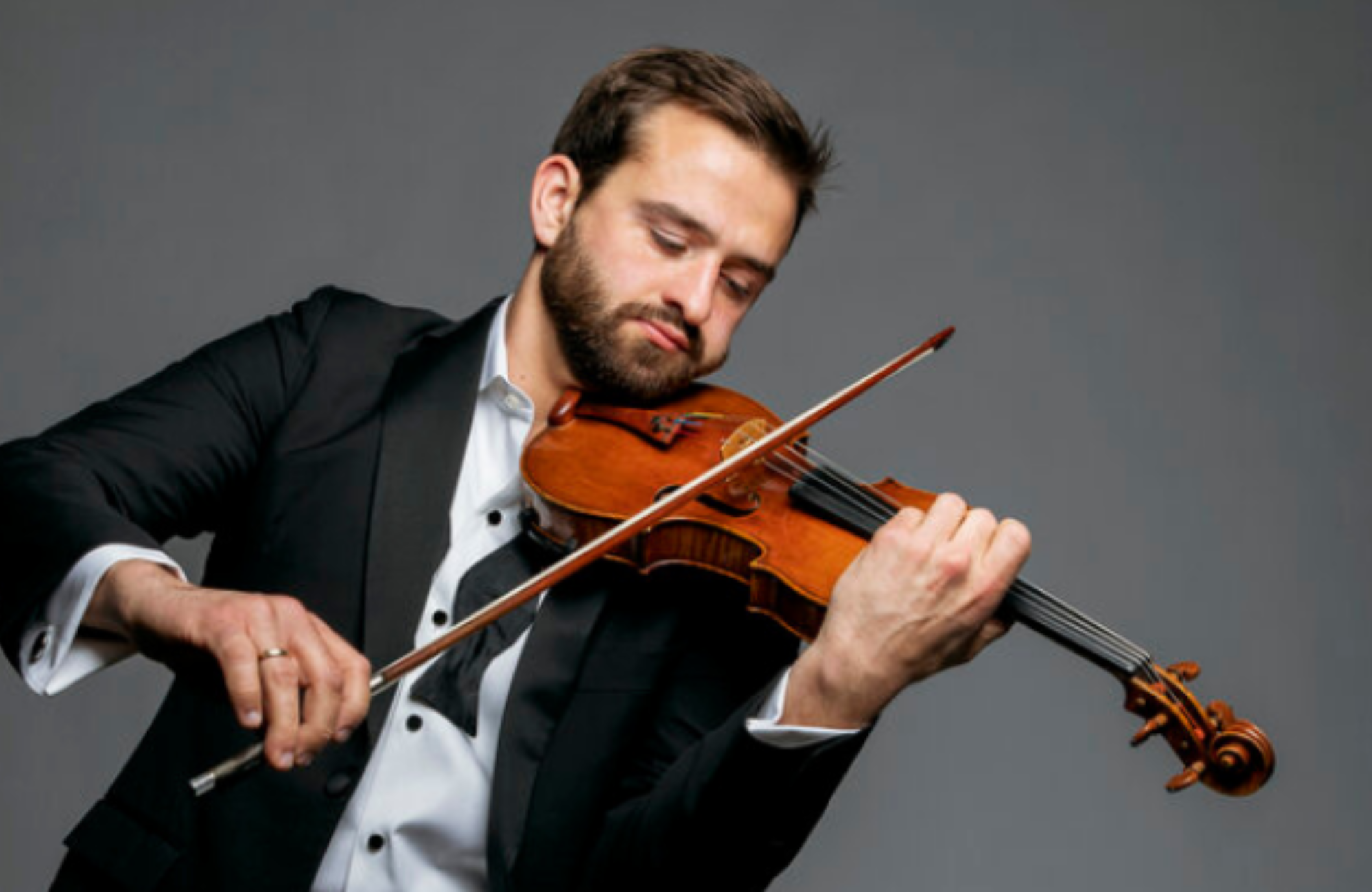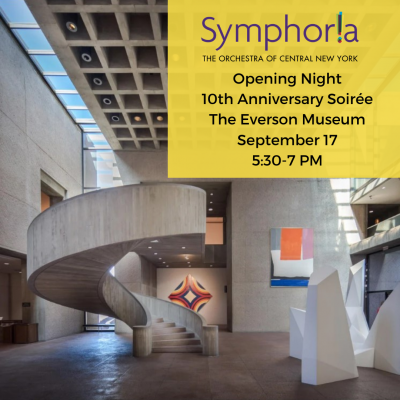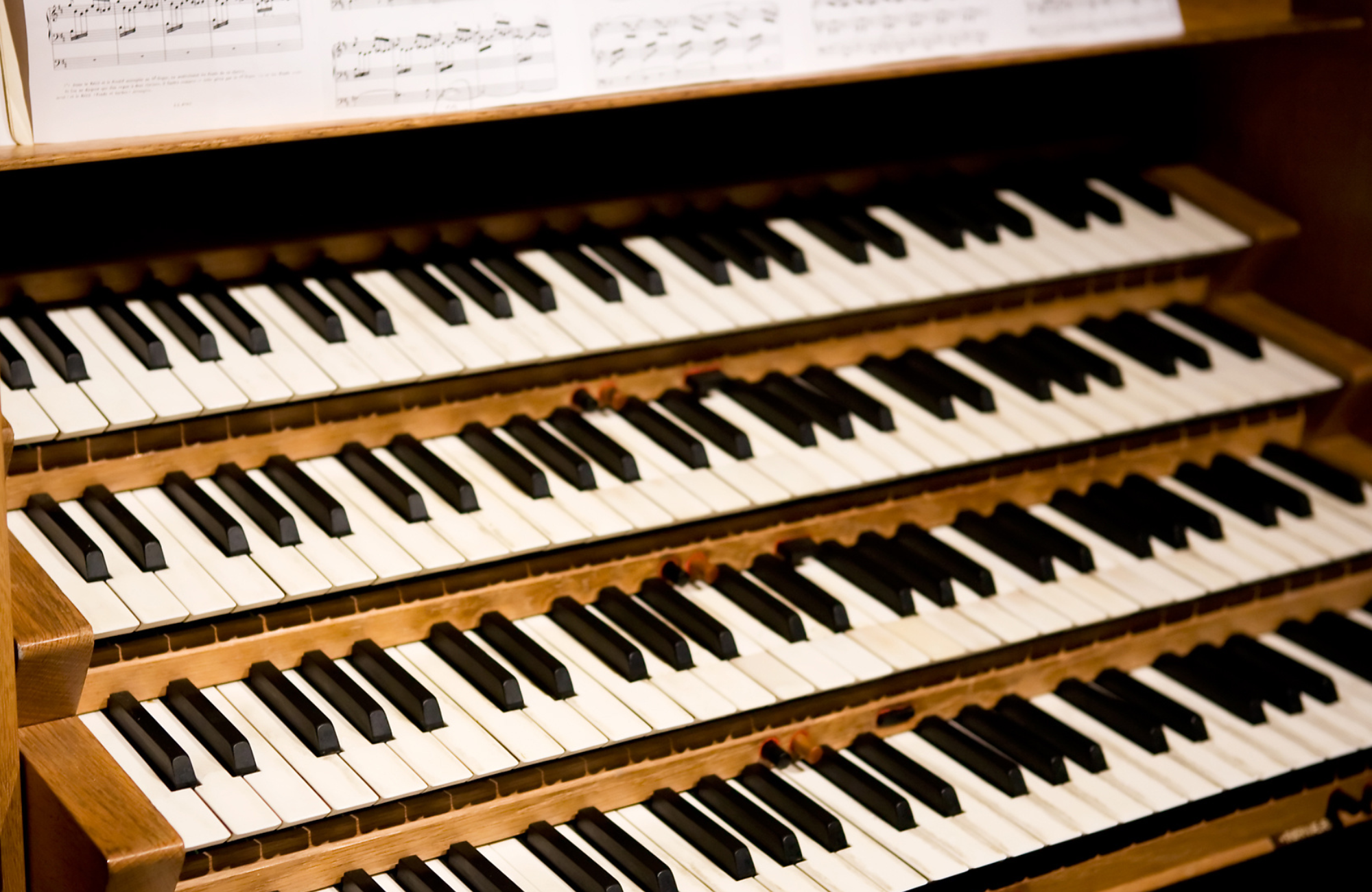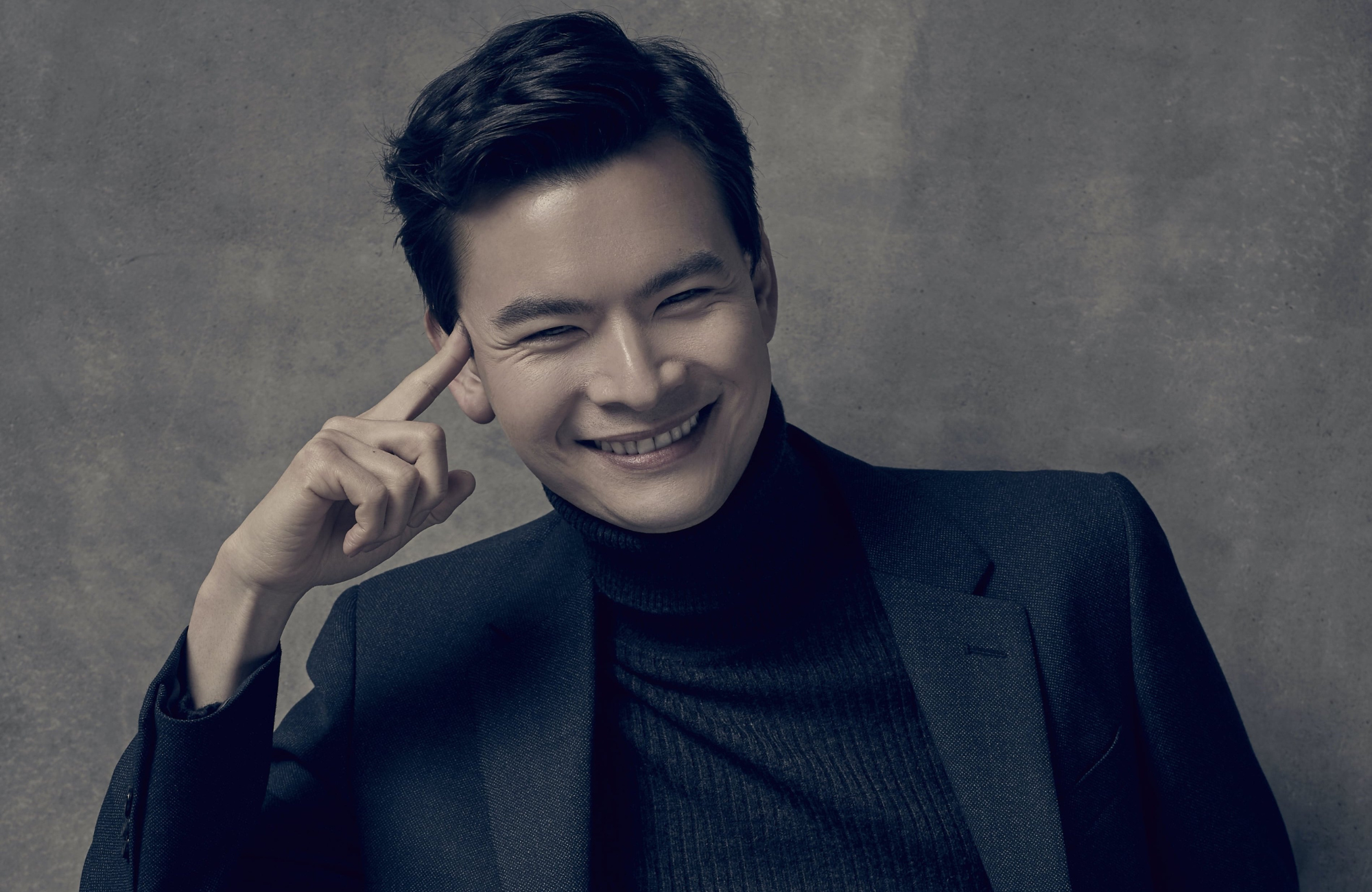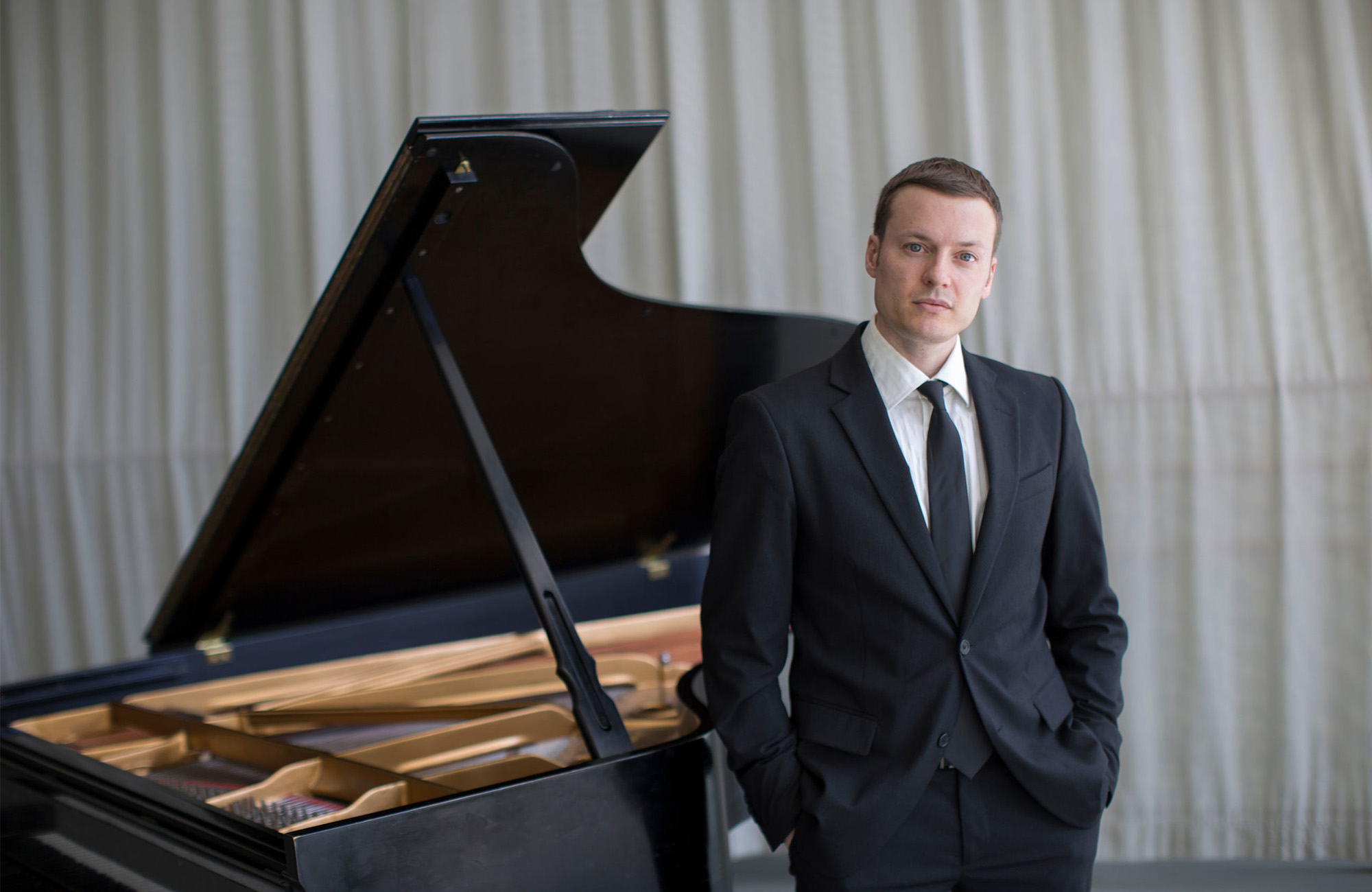Symphoria opens its 10th anniversary season with Valerie Coleman’s beautiful Umoja: Anthem of Unity. William Hagen returns to Syracuse performing Stravinsky’s Violin Concerto and Rachmaninoff’s Symphony No. 2 closes out the night.
Join us at The Everson Museum before the concert for drinks and hors d’oeuvres in celebration of the Opening Concert of our 10th Anniversary Season! Turn the concert into a complete experience in the elegant Sculpture Court of the museum and outdoors on the museum podium if weather permits. Music Director Lawrence Loh will be making a toast to Symphoria and all of you!
$50 per person (without concert ticket) or $95 per person (including best available concert ticket)
Catering by Oh My Darling with a Cash Bar
PROGRAM
SMITH: The Star-Spangled Banner ![]()
COLEMAN: Umoja, Anthem of Unity for Orchestra ![]()
STRAVINSKY: Concerto for Violin in D Major ![]()
RACHMANINOFF: Symphony No. 2 in E minor, Opus 27 ![]()
PROGRAM NOTES
Sergei Rachmaninoff (1873–1943) and Igor Stravinsky (1882–1971) had a lot in common. Born to musical Russian families less than a decade apart, they both chose to emigrate after the Russian Revolution, living in Europe before settling in the United States. As a result, both saw their music banned for a time by Soviet authorities. (A bit of trivia: both celebrated their moves here with arrangements of the “Star Spangled Banner.”) Eventually, both gravitated to Beverly Hills—at a time when Los Angeles was a magnet for musical talent, especially for European refugees. Musically, both were tremendous admirers of Tchaikovsky (in fact, ...
Sergei Rachmaninoff (1873–1943) and Igor Stravinsky (1882–1971) had a lot in common. Born to musical Russian families less than a decade apart, they both chose to emigrate after the Russian Revolution, living in Europe before settling in the United States. As a result, both saw their music banned for a time by Soviet authorities. (A bit of trivia: both celebrated their moves here with arrangements of the “Star Spangled Banner.”) Eventually, both gravitated to Beverly Hills—at a time when Los Angeles was a magnet for musical talent, especially for European refugees. Musically, both were tremendous admirers of Tchaikovsky (in fact, both produced reworkings of Tchaikovsky’s music), and both started out as high romantic composers.
Stylistically, though, they eventually moved in diametrically opposite directions. Rachmaninoff remained loyal to romantic ideals, to music as emotional expression. Stravinsky, in contrast, was a committed modernist increasingly concerned with abstract musical form. He once called Ravel a Swiss watch-maker—but the description could apply as much to him, especially in his later works. Of course, neither Rachmaninoff nor Stravinsky was as pure as that. Rachmaninoff, especially in such later works as the Symphonic Dances and the Third Symphony, experimented with more modernist techniques. Stravinsky, as you will see tonight, was never as chilly as he was sometimes alleged to be. But we chose them to open our season precisely because they play off against each other so well.
Rachmaninoff wrote his Symphony No. 2 in E Minor in 1906 in Dresden. Nearly a decade earlier, his First Symphony had suffered a disastrous premiere. The failure was due to an inadequate performance rather than to any inadequacy in the music; even so, the debacle threw the young composer off balance for years. With the help of therapy from Dr. Nicolai Dahl, however, he recovered; and propelled by the immense success of his Second Piano Concerto, and energized by his marriage and the birth of his first child, he regained the confidence necessary to take up the symphonic genre once again.
Under the circumstances, you might imagine a fresh, optimistic work. As I’ve said before, though, there’s no easy connection between a composer’s actual emotional state and the spirit of his or her music. Yes, the Second does end in resounding triumph. But elsewhere, starting with the somber opening of the first movement (which introduces material heard in various forms throughout the work), the Symphony is brimming with the kind of music that would serve to confirm Stravinsky’s supposed description of Rachmaninoff as a “six and a half foot scowl.” Indeed, as in much of Rachmaninoff’s music, the Dies Irae often casts its shadow. This theme, the plain-chant setting of the “Day of Wrath” from the Latin Requiem Mass, haunted Rachmaninoff throughout his life, appearing, often as a threat, in many of his compositions. It’s heard here most clearly in the second movement, where the horns announce it almost as soon as the movement starts.
Yet while much of the Second is gloomy, its combination of voluptuous harmonies, rich orchestration, and (especially) succulent melodies has made it one of Rachmaninoff’s most beloved works. Its melodic abundance, in fact, may be unmatched by anything else he wrote. For many listeners, the third movement Adagio—which features what’s arguably the most exquisite clarinet solo in the standard orchestral repertoire—stands out (no surprise that this movement has been taken up by several pop and jazz musicians). But in fact, there’s more ravishing melodic material in this one symphony than many composers produce in a lifetime. Even the momentum of the hard-driving second-movement Scherzo is interrupted twice for a melody of heart-stopping splendor, one that almost seems to come from a different world.
It would be hard to imagine anything more different than Stravinsky’s snappy Violin Concerto in D. Certainly, the two works are different in stylistic orientation. If Rachmaninoff’s hyper-romantic work takes Tchaikovsky as its North Star, Stravinsky’s neo-classical effort is guided by the spirit of Bach. (The Double Concerto for Two Violins and Orchestra was especially influential.) The two works are dramatically different in color, as well. If Rachmaninoff’s has deep luster, Stravinsky’s has a bright sparkle. What makes the Concerto’s lightness especially remarkable is that Stravinsky’s score calls for a larger brass-and-woodwind contingent than any other violin concerto in the standard repertoire (in fact, it’s marginally larger than what we find in the Rachmaninoff Second). Yet Stravinsky creates a delicate, chamber music sound, using his large orchestral complement to create a dazzling variety of colors rather than to generate the sheer weight and plush that Rachmaninoff favors.
Then, too, the works differ in scale. Rachmaninoff’s score is expansive. It’s by far his longest orchestral work—sufficiently so that, in the days before the composer was fully accepted into the canon, conductors used to introduce cuts. Stravinsky’s is about a third as long. (Each of its four compact movements, by the way, is introduced by a striking chord—which appears elsewhere in the piece as well—that Stravinsky called the Concerto’s “passport.” It stretches so widely that Samuel Dushkin, the violinist for whom the work was written, at first thought it unplayable.)
Most important, the Rachmaninoff, like nearly all his works, is profoundly serious. The Stravinsky is, in the words of tonight’s soloist Will Hagen, “so much fun. It’s a really comedic piece—so quirky, a groovy piece. If you play it as if it’s the second movement of the Beethoven”—or, for that matter, as if it’s the Rachmaninoff Second Symphony—“you’ve totally missed the point, and it’s going to fall flat.”
True, says Will, there’s some seriousness in the third movement, a moment of supreme melodic beauty. Bach may have been the immediate influence, but it’s hard not to think of Tchaikovsky as well. Indeed, only a couple of years separate the Violin Concerto from Stravinsky’s ballet Le baiser de la fée, based on themes by Tchaikovsky. On the whole, though, the Concerto is what Will calls a “dancy” piece, and he promises that he, conductor Larry Loh, and the orchestra will be “having a party.” The dance elements should be no surprise. Stravinsky competes with Tchaikovsky as the greatest composer for ballet; and even though the Concerto was written as an abstract concert work, George Balanchine saw its dance potential and used it as music for two different ballets. One of them, coincidentally, is returning to the New York City Ballet next week.
Our opening work, Umoje, by flutist and composer Valerie Coleman (b. 1970), has a strong dance impulse, too. Umoje is the Swahili word for Unity, the first principle of Kwanzaa—and the music started out as a simple song for women’s choir. Over the years, Coleman produced multiple versions, including an enormously popular version for wind quintet. But in 2019, it was significantly expanded into a full-orchestra work for the Philadelphia Orchestra with a more complex musical outline and a richer sonic palette (note, for instance, the use of bows on the mallet instruments at the very beginning). At the heart of the piece is still the same infectious melody, which, in the composer’s words, “dances and weaves throughout the instrument families.” But in the new orchestral version, it’s threatened by “dissonant viewpoints” representing “the clash of injustices, racism and hate.” In the end, though, affirmation triumphs: “Now more than ever,” says Coleman, “Umoja has to ring as a strong and beautiful anthem for the world we live in today.” Its dedication to community makes Umoja a perfect opener for our tenth anniversary season.
Peter J. Rabinowitz
Have any comments or questions? Please write to me at prabinowitz@ExperienceSymphoria.org
FEATURED ARTISTS
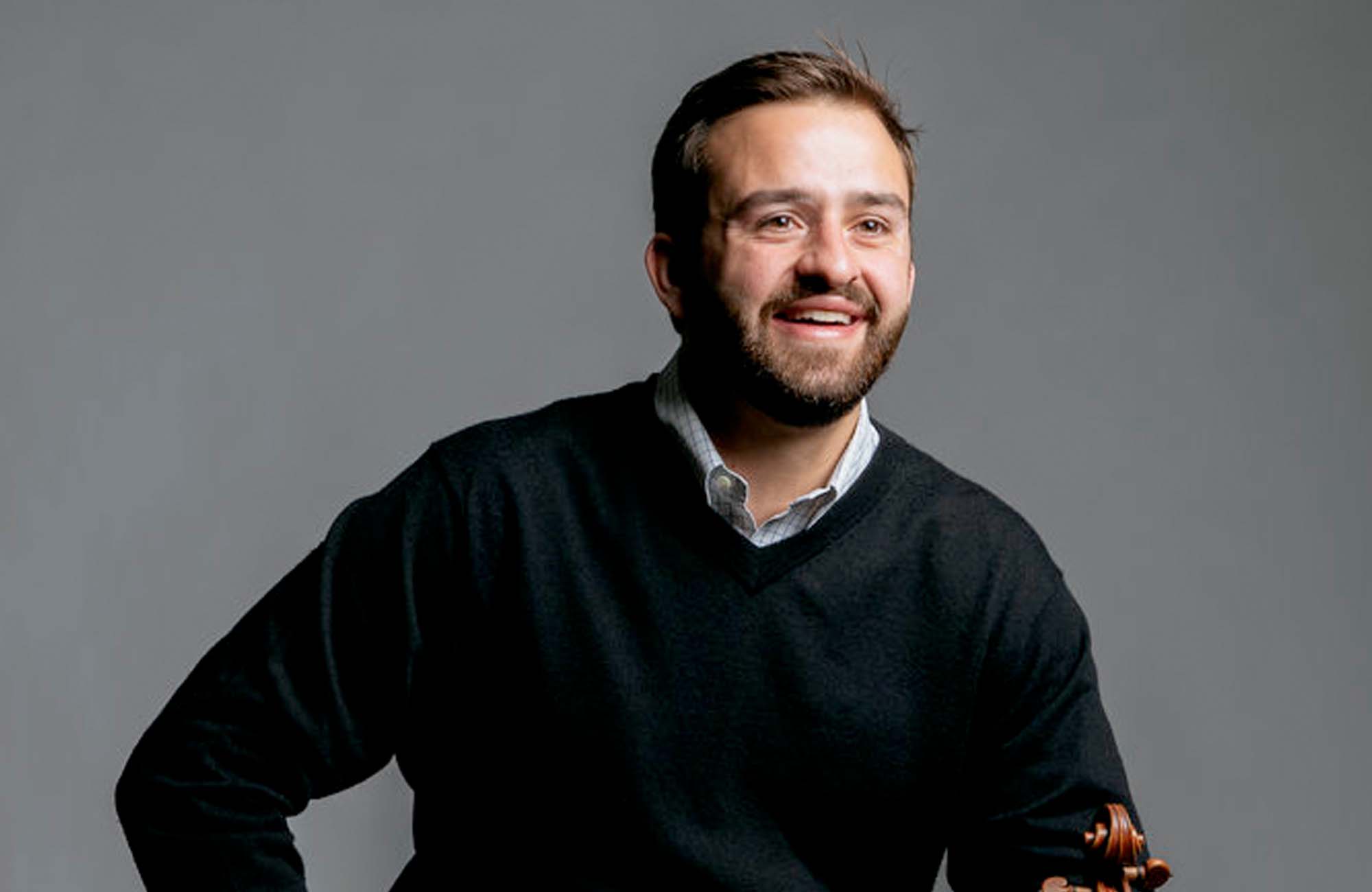
The riveting 30-year-old American violinist William Hagen has appeared as a soloist with many of the world’s great orchestras including the Chicago Symphony, Chamber Orchestra of Europe, San Francisco Symphony, Frankfurt Radio Symphony, and many more. Already a seasoned international performer who has won friends around the world, ...
The riveting 30-year-old American violinist William Hagen has appeared as a soloist with many of the world’s great orchestras including the Chicago Symphony, Chamber Orchestra of Europe, San Francisco Symphony, Frankfurt Radio Symphony, and many more. Already a seasoned international performer who has won friends around the world, William has been hailed as a “brilliant virtuoso…a standout” (The Dallas Morning News) whose playing is “… captivating, floating delicately above the orchestra” (Chicago Classical Review). He was the third-prize winner of the 2015 Queen Elisabeth International Music Competition, one of the highest-ranking Americans ever in the prestigious competition. William performs on the 1732 ‘Arkwright Lady Rebecca Sylvan’ Stradivarius, on generous loan from the Rachel Barton Pine Foundation.
Hagen’s recent performances include appearances with the Rochester Philharmonic and Asheville Symphony, and performances at the Ravinia, Grant Park, Sunriver, and Santa Fe Chamber Music festivals and Tippet Rise Art Center. Hagen’s 2023-24 season highlights include performances for the Chamber Music Society of Fort Worth, Detroit Symphony, a European tour with the Amsterdam Sinfonietta, and collaborations with cellist Andrei Ioniță and pianists Orion Weiss and Albert CanoSmit. This season William offers a new community engagement initiative that combines conversations with local gardening experts with an interactive performance and explores the ways in which music and nature are connected.
William has performed with conductor Nicolas McGegan both at the Aspen Music Festival and with the Pasadena Symphony, and made his debut with the Oregon Symphony under Carlos Kalmar, performed with the Brussels Chamber Orchestra in Beijing and at the Aspen Music Festival with conductor Ludovic Morlot, and played recitals in Paris, Brussels, and at the Ravinia Festival. Collaborations include those with Steven Isserlis at the Wigmore Hall, with Tabea Zimmermann at the Beethovenhaus in Bonn, with Gidon Kremer, Steven Isserlis, and Christian Tetzlaff in Germany, and in New York City with the Jupiter Chamber Players.
Since his debut with the Utah Symphony at age nine, William has performed with conductors such as Marin Alsop, Christian Arming, Miguel Harth-Bedoya, Michel Tabachnik, and Hugh Wolff. A native of Salt Lake City, William first heard the violin when he was 3 and began taking lessons at age 4 with Natalie Reed, followed by Deborah Moench. At age 10, he began studying with Robert Lipsett at the Colburn School in Los Angeles, where he studied until the age of 17.
After studying at the Juilliard School for two years with Itzhak Perlman, William returned to Los Angeles to continue studying with Robert Lipsett at the Colburn Conservatory. He then went on to study at the Kronberg Academy in Germany with Christian Tetzlaff. William is an alumnus of the Verbier Academy in Switzerland, the Perlman Music Program, and the Aspen Music Festival.
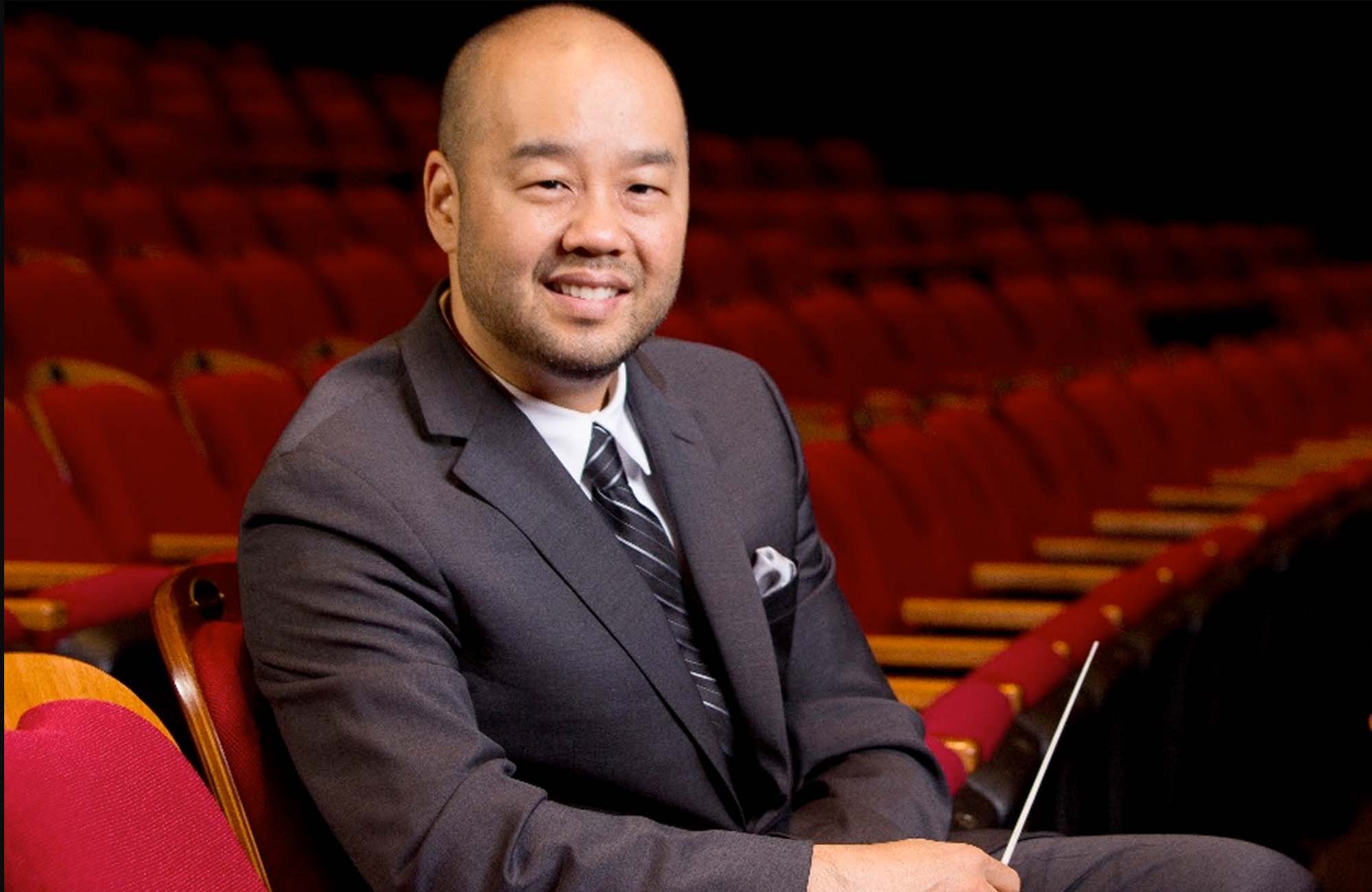
Described as bringing an “artisan storyteller’s sensitivity… shaping passages with clarity and power via beautifully sculpted dynamics… revealing orchestral character not seen or heard before” (Arts Knoxville) Lawrence Loh enjoys a dynamic career as a conductor of orchestras all over the world.
After an extensive two ...
Described as bringing an “artisan storyteller’s sensitivity… shaping passages with clarity and power via beautifully sculpted dynamics… revealing orchestral character not seen or heard before” (Arts Knoxville) Lawrence Loh enjoys a dynamic career as a conductor of orchestras all over the world.
After an extensive two year search, Lawrence Loh was recently named Music Director of the Waco Symphony Orchestra beginning in the Spring of 2024. Since 2015, he has served as Music Director of The Syracuse Orchestra (formerly called Symphoria), the successor to the Syracuse Symphony Orchestra. “The connection between the organization and its audience is one of the qualities that’s come to define Syracuse’s symphony as it wraps up its 10th season, a milestone that might have seemed impossible at the beginning,” (Syracuse.com) The Syracuse Orchestra and Lawrence Loh show that it is possible to create a “new, more sustainable artistic institution from the ground up.”
Appointed Assistant Conductor of the Pittsburgh Symphony in 2005, Mr Loh was quickly promoted to Associate and Resident Conductor within the first three years of working with the PSO. Always a favorite among Pittsburgh audiences, Loh returns frequently to his adopted city to conduct the PSO in a variety of concerts. Mr. Loh previously served as Music Director of the West Virginia Symphony Orchestra, Music Director of the Northeastern Pennsylvania Philharmonic, Artistic Director and Principal Conductor of the Syracuse Opera, Music Director of the Pittsburgh Youth Symphony Orchestra, Associate Conductor of the Dallas Symphony Orchestra, Associate Conductor of the Colorado Symphony Orchestra and Music Director of the Denver Young Artists Orchestra.
Mr. Loh’s recent guest conducting engagements include the San Francisco Symphony, Dallas Symphony, North Carolina Symphony, Baltimore Symphony, Sarasota Orchestra, Florida Orchestra, Pensacola Symphony, Atlanta Symphony, National Symphony, Detroit Symphony, San Diego Symphony, Seattle Symphony, National Symphony (D.C.), Utah Symphony, Rochester Philharmonic, Indianapolis Symphony, Calgary Philharmonic, Buffalo Philharmonic, Albany Symphony and the Cathedral Choral Society at the Washington National Cathedral. His summer appearances include the festivals of Grant Park, Boston University Tanglewood Institute, Tanglewood with the Boston Pops, Chautauqua, Sun Valley, Shippensburg, Bravo Vail Valley, the Kinhaven Music School and the Performing Arts Institute (PA).
As a self-described “Star Wars geek” and film music enthusiast, Loh has conducted numerous sold-out John Williams and film music tribute concerts. Part of his appeal is his ability to serve as both host and conductor. “It is his enthusiasm for Williams’ music and the films for which it was written that is Loh’s great strength in this program. A fan’s enthusiasm drives his performances in broad strokes and details and fills his speaking to the audience with irresistible appeal. He used no cue cards. One felt he could speak at filibuster length on Williams’ music.” (Pittsburgh Tribune)
Mr Loh has assisted John Williams on multiple occasions and has worked with a wide range of pops artists from Chris Botti and Ann Hampton Callaway to Jason Alexander and Idina Menzel. As one of the most requested conductors for conducting Films in Concert, Loh has led Black Panther, Star Wars (Episodes 4-6), Jaws, Nightmare Before Christmas, Jurassic Park, Casablanca, The Wizard of Oz and Singin’ in the Rain, among other film productions.
Lawrence Loh received his Artist Diploma in Orchestral Conducting from Yale, his Masters in Choral Conducting from Indiana University and his Bachelor of Arts from the University of Rochester. Lawrence Loh was born in southern California of Korean parentage and raised in Carlisle, Pennsylvania. He and his wife Jennifer have a son, Charlie, and a daughter, Hilary. Follow him on instagram @conductorlarryloh or Facebook at @lawrencelohconductor or visit his website, www.lawrenceloh.com


